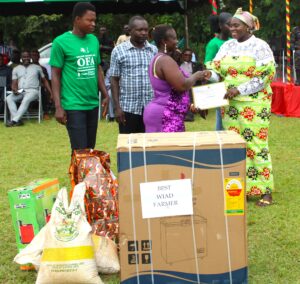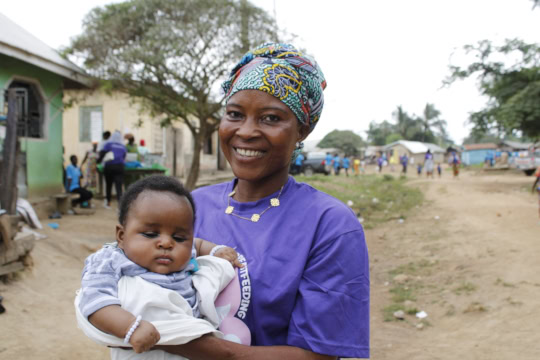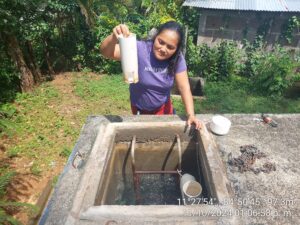El Juste Farmers See the Benefits of QPM Seed and New Farming Methods
By Jorge L. Campos S. and Rodolfo Hernandez – Nicaragua Country Director & Ag Program Officer

Proud farmers in the El Juste community
Maize producers in the community of El Juste participated in a seminar about how to get higher yields of the INTA-Nutrader quality protein maize (QPM). The seminar was held at Self-Help International’s Fred W. Strohbehn Training Center in collaboration with the San Marcos y San Lucas and Los Chiles y COOPEMEL RL cooperatives of Melchorita, in the Río San Juan department, as part of the agricultural extension activities of Self-Help.
Nicaraguan government official Ramón González arranged a meeting for 25 farmers in El Juste to participate in a Self-Help seminar highlighting the importance of QPM seed. Agricultural productivity is improved by focusing on food and nutritional security. Self-Help focuses on addressing the following agronomic issues: climate change, biofortified crops; efficient use of fertilization; weed and pest management; methods of selecting seed; recommendations for harvest and post-harvest; and grain storage. In addition to talking about the benefits of QPM seed and sharing information, Self-Help’s agriculture team offered a practical demonstration to carry out the double-row planting method. Two QPM seed producers from the Los Chiles farmers cooperative, Isidro and Ariel, worked with the Self-Help team to carry out the training.
The President of the El Juste Farmers Cooperative Says Farmers See the Benefits
President of the 20 member El Juste farmers cooperative, Juan, checked in with Self-Help’s agriculture team 65 days after planting his first demonstration plot of QPM.
“This is the first time we’re doing this study in El Juste with our cooperative. We’ve got the INTA-Nutrader QPM seed variety in our demonstration plot,” Juan said. “The El Juste farmers agreed to let Self-Help come teach us about this new seed and these new farming methods. Now, we see that the demonstration plot is showing us the benefits of the INTA-Nutrader QPM seed.
“In our community, there was a dry month, and we didn’t get rain. We believed we would be affected and that our maize crop would be short,” Juan said. “However, our crops are the right height.
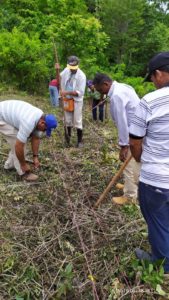
El Juste farmers doing double-row planting
“We were also worried we would not produce much, but now we see that we are duplicating the results. Farmers tell us they are doing magic due to this experience. We’ve now seen the results of our experiments. We learned a new technology for free, and this continues paying us back because we use this technology to work and to earn a day’s wage,” Juan said.
Juan told Self-Help staff that he’s planted four pounds of INTA-Nutrader maize (625 square yards), and the farmers cooperative is thinking they’ll harvest some 3,000 corn cobs which will sell at approximately 3 cordobas per unit for a total of 9,000 cordobas (~$270USD). The farmers cooperative generated some 2,000 cordobas in costs, leaving them a net profit of 7,000 cordobas (~$210USD).
“We now see that INTA-Nutrader QPM seed can be planted in double rows to increase our yields. We’ve seen the results,” Juan said. “Sincerely, this experience has also become a sort of educational resource in our region because the farmers pass by our farms and ask how we get such a high crop yield. It’s been a very, very good learning opportunity that has had a lot of benefits for our region.
“Farmers participated in the first demonstration plot that we planted during the practice day with Self-Help staff. Now, us farmers have results which are now in the stage of chilote (baby corn). One of the characteristics of this corn is that it gives chilote in 90% of the plants, so it’s got double purpose because it yields both kinds of chilote and elote (young dry corn),” Juan said. “Today we took 24 dozen at 10 cordobas, we’re speaking about 500 cordobas! Until it is in elote we are going to do this step in the evaluation.
“It’s truly been a success. It’s the first time that we’ve done this training and the first time we’ve planted this QPM seed variety, and we are seeing the results,” Juan said. “We are thinking about reducing the cultivation area to be able to plant less, using this technology, and putting into practice what Self-Help has taught us. We are proud to share our experience with other farmers, and it’s satisfying for us to know that other farmers are also obtaining successful results in their work.”
“We’ve also learned about planting in double rows to increase our yields, and we’ve seen the results,” Juan said. “Sincerely, this experience has also become a sort of educational resource in our region because the farmers pass by our farms and ask how we get such a high crop yield. It’s been a very, very good learning opportunity that has had a lot of benefits for our region.”
Nicaragua Country Director, Jorge Campos, Provides Perspective
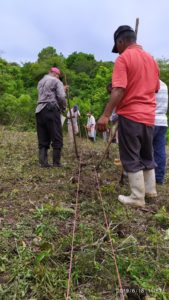
El Juste farmers doing double row planting
“It’s evident that the teachings of SHI are impacting the lives of farmers, as well as their practices of maize management,” said Jorge Campos, Nicaragua Country Director. “Helping farmers take advantage of the INTA-Nutrader QPM seed brings new experiences at the technical level and knowledge management to farmers.
“Teaching about QPM seed also helps rural families with food security and helps them increase their incomes,” Jorge added. “We are bringing these farmers to the next level, and the best part is the way that agricultural extension and demonstration plots impacts families’ crop production and nourishment. The farmers’ new experiences turn them into farmers who are more resilient against the effects of climate change (such as drier seasons) and guarantee rural families’ food and nutritional security.”

